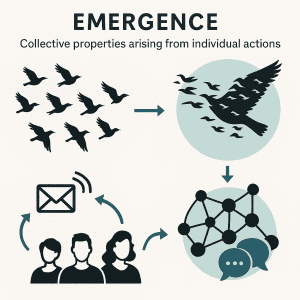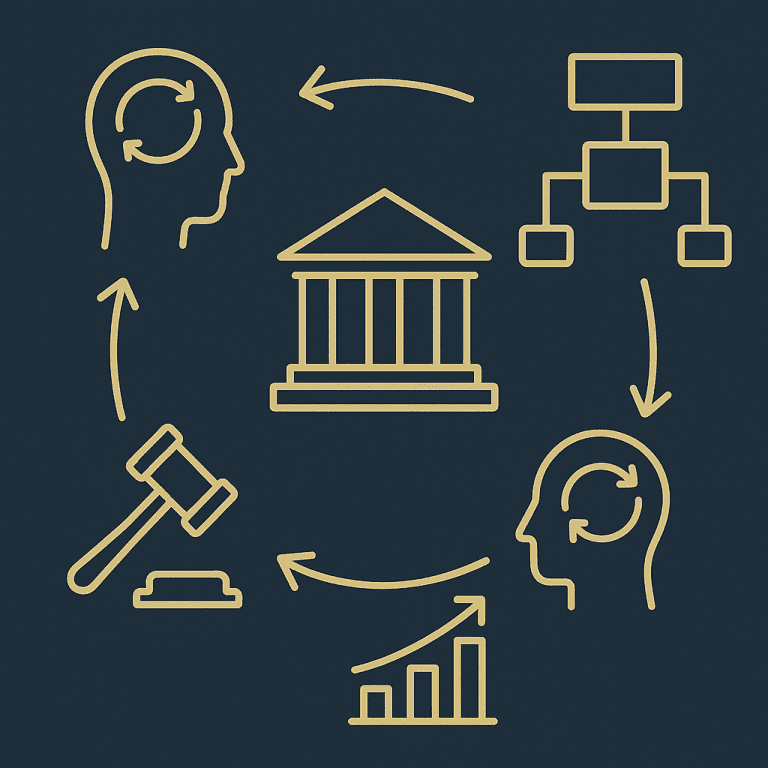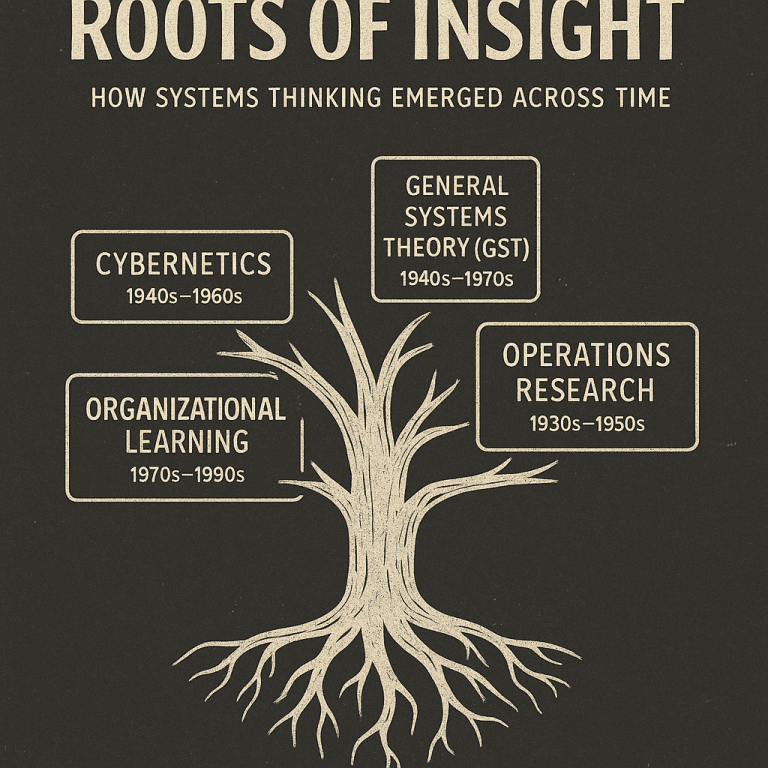Emergence, Feedback, and the Flow of Change
Some things can’t be predicted — not because we’re not smart enough, but because they simply unfold.
A flock of birds turning in perfect sync.
A market crash.
A viral campaign.
A company culture shift.
A revolution.
None of these are traditionally planned.
They arise through interaction, not instruction.
They are the unpredictable symphony of parts influencing each other.
This is the dance of systems.
In this post, we’ll explore the core patterns that make systems alive — and challenging for anyone trying to manage or influence them.
🌱 Emergence: When the Whole Surprises You
Emergence is when something new arises from the interaction of parts — something you couldn’t see by looking at the parts in isolation. It’s the “aha!” moment when collective behavior is more than the sum of individual components.
🔍 You can’t understand the dynamics of a thriving city by analyzing a single building.
Nor can you grasp the power of a symphony by listening to one instrument.

Emergence means:
- Culture emerges from daily interactions, shared stories, rules, values, and rituals — not from an HR manual.
- Traffic jams emerge from individual driving decisions, road design, timing, and surprise events — not from one car breaking down.
- Innovation emerges from trust, pressure, feedback, freedom to fail, and spontaneous collaboration — not just hiring a few smart people.
For consultants, understanding emergence is gold.
It shifts your lens from isolated causes to systemic patterns.
Success — and failure — often emerge as patterns, not accidents.
Your job is to nurture the conditions that allow the right behaviors to emerge — and quietly dissolve those that fuel the wrong ones.
🎯 Ask yourself and your clients:
- What collective behaviors consistently show up — even if no one designed them?
- When people collaborate here, what actually emerges — excellence, confusion, trust, fear?
- What outcomes does this system produce, regardless of its stated mission?
- Are we trying to control something that can only be influenced indirectly, by adjusting the deeper structure?
🔁 Feedback Loops: The Hidden Engine of Systems
At the heart of every living system lies the feedback loop — a circular process where a system’s output loops back as input, influencing future behavior.
Feedback loops drive growth, collapse, balance, and instability.
Spotting them is one of the most powerful skills a consultant can master.
There are two main types:
🔄 Reinforcing Feedback (Growth or Decline Spirals)
Analogy: “The rich get richer.” “A snowball rolls downhill.”
This loop amplifies change. More of X leads to more of Y, which reinforces more of X.
Examples:
- A viral product → attracts more users → generates more buzz → attracts even more users. (Growth spiral)
- Confidence → leads to strong performance → increases confidence → leads to better performance. (Virtuous cycle)
- Panic selling → crashes the market → causes more panic → fuels further selling. (Collapse spiral)
Reinforcing loops can drive explosive success — or dangerous decline.
⚖️ Balancing Feedback (Stability or Resistance)
Analogy: “The body sweats to cool down.” “The thermostat kicks in to maintain room temperature.”
This loop resists change. When X increases, Y reduces it, keeping the system stable.
Examples:
- A thermostat turns off heat when the room gets too warm.
- Overworked teams naturally slow down to avoid burnout.
- Central banks raise interest rates to cool inflation.
Healthy systems need both loops — reinforcing ones for change, balancing ones for stability.
Your job is to find them, name them, and ask whether they’re working with or against your client’s goals.
⏳ Delays: The Time Trap
Delays are invisible gaps between action and effect.
They’re everywhere — and they distort how people think and act.
Examples:
- Eat healthy today, lose weight weeks later.
- Launch a new policy, see behavior shift months later.
- Begin a culture change, wait years to fully feel it.
Delays confuse cause and effect. If results don’t show fast, we wrongly assume “it’s not working” and abandon the effort.
🚫 The danger?
Pushing harder on a system that simply needs time — or switching tactics too early.
🎯 Ask:
- Where might delays be hiding in this process?
- Are we expecting quick wins from a system that moves slowly by nature?
- Could today’s pain be the delayed result of yesterday’s decisions?
- How can we design change strategies with realistic pacing and patience?
🔀 Non-linearity: When the World Doesn’t Behave
In non-linear systems, the relationship between cause and effect isn’t proportional.
Small efforts sometimes create huge change.
Huge efforts sometimes create almost none.
Examples:
- A toxic hire quietly dismantles team cohesion.
- A tiny UX tweak makes a product explode in popularity.
- A subtle policy shift cascades into massive industry disruption.
Non-linear systems don’t behave like straight lines. They curve, ripple, tip, and collapse.
🎯 Consultant Rule of Thumb:
Never assume effort equals impact.
Ask:
- “What if a tiny nudge here could unlock a big shift?”
- “Are we pushing in the wrong place — too far from a leverage point or past a tipping point?”
- “What thresholds might exist here, where the system suddenly shifts?”
💬 Real Talk: Why This Matters to Consultants
Persistent problems — the kind that keep resurfacing no matter what — rarely exist because people are lazy or incompetent.
They’re often the result of:
- Unseen feedback loops
- Misjudged delays
- Oversimplified linear thinking
- Unrecognized emergence
When you understand these dynamics, you stop wrestling with symptoms and start influencing the structure and flow beneath them.
You’ll be able to:
✅ Identify where true change starts
✅ Design smarter, more ethical interventions
✅ Prevent unintended consequences
✅ Gain deeper client trust
✅ Deliver change that sticks
🛠 Mini-Practice: Analyze a Recurring Problem
Pick a stubborn issue you or your client face. Then ask:
- What’s reinforcing it? Are there feedback loops keeping it alive?
- Is there a balancing loop resisting change? Why isn’t it stabilizing the system?
- Are delays distorting our perception of progress?
- Is the system behaving in a non-linear way? Could we be near a tipping point?
Bonus: Sketch a quick feedback loop for your problem — it doesn’t need to be pretty. Just start seeing the cycle.
🧠 Final Thought
Systems don’t sit still.
They ripple.
They push back.
They transform.
When you understand emergence, feedback, delays, and non-linearity, you stop expecting control…
…and start working with the living rhythm of change.
This is the shift that separates the consultant who gives good advice…
…from the one who rewires reality.
Ready to stop wrestling with symptoms — and start dancing with the deeper currents of change?
- The Whisper of the Whole: A Systems Thinking Guide for Consultants
- What is a System, Really?
- The Living Dance of Systems
- Resilience and the Wisdom of Adaptive Systems
- Roots of Insight
- The Systems Thinker’s Compass
- Drawing Complexity
- Peering Below the Surface
- Master Methodologies in Systems Thinking
- Enhancing Familiar Tools with Systems Thinking
- Transforming Business Through Systems Thinking
- Systems Thinking in Public Policy & Governance
- Sustainable Systems
- Systems Thinking for Engineering & Technology
- The Inner System: You
- The Roadblocks
- The Future of Systems Thinking
- Systems Thinking FAQ: Myths, Misunderstandings & Core Insights







